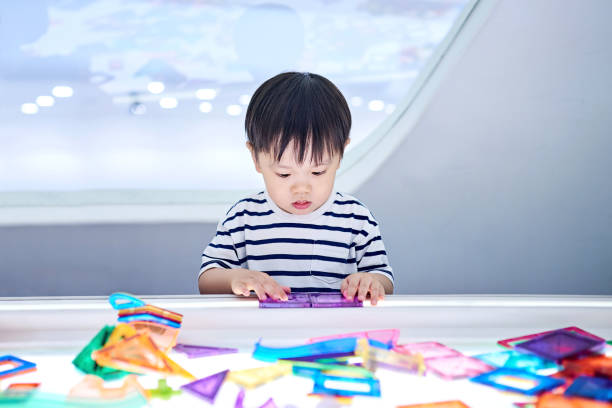You know, playtime isn’t all about games and fun if you’ve seen the concentration of a child trying to put a block in a hole or catch a soccer ball mid-air. Toys are tools for the job.
This age-based guide will help you understand how children play and the best toys to entertain them, teach them social and emotional skills and stimulate their developing brains.
Babies and their Play
Exploration is the focus of play in the first year. Baby’s five senses help them explore the world. Is it sticky or rough? What happens if I drop the product? What happens if I put it in my hand? Most play involves “tasting,” or mouthing, an object and shaking, banging, or dropping it.
Play becomes more complex and coordinated as your baby’s motor skills develop. You can, for example:
- Around four months, babies start to grasp and reach for objects like rattles.
- They can transfer the rattle from one hand to another in 6 or 7 months.
- Around nine months old, the newly developed pincer grip makes it easier for infants to pick up small objects like blocks or other toys.
Playing alone is the norm during this period, but by the end of the year, babies often play with each other and mimic activities.
You are the baby’s favorite toy for now. You may have danced a toy before the baby’s eyes, but he grabbed it and pulled it towards his mouth. Have you ever heard him squeal in delight and anticipation when you sneak up on him and say, “I am going to get you!”
These interactions teach your baby about language, cause-and-effect, and social relationships. When babies understand the relationships between the things they encounter in their environment, including how they feel, smell, taste, and sound, they are ready to move on to the next development phase.
Smart Toys for Babies
- Nursery mobile. Moving objects above a baby’s head lying in his crib develops attention span and stimulates vision.
- Mirror. At first, your baby is fascinated by the changing expressions and faces in the mirror. Your baby will eventually realize that the smiling, drooling baby in the mirror is a reflection. As soon as this occurs, the baby becomes aware of himself, leading to further self-discovery.
- The classic toy is a cone with different colored rings. At first, babies love to hold and mouth the rings. The rings are then used to develop fine motor skills as they fit them onto the cone. Stacking the circles in different colors helps toddlers learn about numbers and colors.
- Push and pull toys. These are great for developing balance, large muscles, and coordination as your child moves from being a couch surfer to walking. The more your baby pushes and pulls, the more muscles they use to become runners and climbers. In the toddler years, children can use them to control their speed.
Toddlers and their Play
- Toddlers begin to understand the purpose of objects. They enjoy stacking blocks, talking into a toy telephone, or drinking from a cup for “big kids.” Pretend play begins now. You can have your child tuck in a doll at night or push a train while making “choo-choo” sounds.
- It lays the foundation for play in preschool, as your child will begin to understand that every item has a purpose.
- Also, your toddler will start to distinguish between colors and shapes. Choose colorful, bright, and easy-to-grasp toys for small hands. By age 2, most toddlers can kick a soccer ball, draw with crayons, and build four-block towers or higher. By age 3, they can do simple puzzles and pedal a tricycle.
- You can expect to see lots of repetition. That’s the way little ones learn new skills and gain some control over their environment.
Smart Toys For Toddlers
-
- Balls. They can be bounced, rolled, or caught to improve gross motor skills and hand-eye coordination.
- Shape sorting toys. Nesting cups, blocks or nesting cups, and buckets that have holes for different-shaped blocks will challenge your hand-eye coordination.
- Mechanical toys Pop-up toys and “busy boxes” with knobs and buttons encourage fine motor skills, problem-solving, and cause and effect.
- Role-play toys. Toys like doctor’s kits and golf sets can help your child learn about the world by mimicking the actions of adults. Dolls and soft toys encourage pretend play. (A tea party with teddy bears, perhaps?) Toys and dolls can help with social and emotional growth by teaching children how to show their emotions and care for something they like.
Preschoolers and Their Play
- Babies use their five senses to explore the world around them. Toddlers begin to understand how things work. As preschoolers, children will use toys, books, and other items for the purpose intended but also imagine other uses for them. Throwing a blanket over a coffee table can transform it into a secret clubhouse. You can make pizza using modeling clay.
- Preschoolers see the world as a magical, limitless place. They are the creators and masters of this magic. Many children at this age believe they possess magical powers and can defeat “monsters” or transform into a fairy, princess, or other whimsical creature.
- Your preschooler may pull you into an imaginary world and expect you to play along. During this time, imaginary friends might “appear.” Fantasy play is essential for children’s development, as it helps them to work through their fears, anxieties, and hopes.
- Expect to hear a lot of “mommy and daddy, please watch!” As your preschooler continues learning new tricks and asks for your approval, your child’s desire to connect with others grows. As preschoolers learn to share and cooperate, they also want to communicate with their friends.

